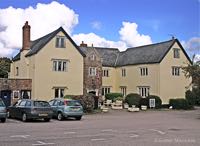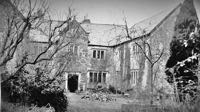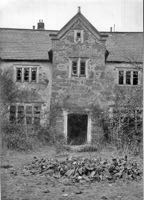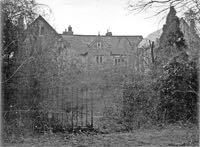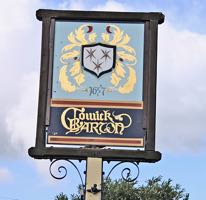
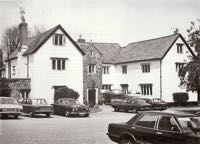 Cowick Barton–Cowick Lane
Cowick Barton–Cowick Lane
Page updated 1st July 2018
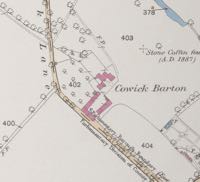 The site of the Cowick Barton public house can be traced back to the twelfth century
when it was part of the newly constructed Cowick Priory, which was situated a little to the
east of the present house. It is possible, but not confirmed, that there was a home farm for
the priory on the site of the house. The Priory became one of the holdings of the Monks
The site of the Cowick Barton public house can be traced back to the twelfth century
when it was part of the newly constructed Cowick Priory, which was situated a little to the
east of the present house. It is possible, but not confirmed, that there was a home farm for
the priory on the site of the house. The Priory became one of the holdings of the Monks
of Tavistock in 1462.
Cowick Priory was appropriated by Henry VI for its revenues to support Eton College. Henry's son, Edward IV annulled the arrangement and passed the property on to the Abbot of Tavistock, in whose care it remained until the dissolution.
Henry VIII’s Reformation was just as traumatic for the Monks of Cowick as it was for many other priories and abbeys around the country. Four months after the deed of surrender was signed in 1539, at Tavistock, and the manors of "Cowick, with its members, Exwyck, Barley, Olderiggs, Cobelynche, Whympell (which had been the gift to Cowick of the Courtenays) and Woodemarston, (which) then produced an inclusive rental of £78 16s. 7¼d. per annum." were handed over to Lord Russell, who evicted the remaining monks.The priory church and buildings were quickly demolished, and the books and church ornaments sold.
The House
Lord Russell constructed Cowick Barton mansion in 1540, possibly using some of the stone from the demolished priory and church. It is thought that it was built to house his bailiff, who would administer his recently acquired manors. The house is constructed of Heavitree stone in the classic Tudor ‘E’ style layout. The plastered exterior retains its original stone mullioned windows along with the original three-storey porch and arched entrance. The building contained a stained-glass window, depicting the arms of Edward VI, Prince of Wales, which can now be found in the Victoria and Albert Museum. A chimney piece dating from 1657 has the arms of the Baron family above it. There are some plaster reliefs, one of a nun caring for some children and one of a maiden with long hair, both standing on the head of an obese friar. A Bible reference, ‘I press towards the mark’, is said to be a coded instruction for a priest hole. There is a trapdoor in the floor that leads to a cellar and passages that may have been the secret hideaway.
Sold On
Descendents of Lord Russell became the Earls of Bedford, with large estates in Devon and eastern England. The 4th Earl was involved in draining the Fens, an undertaking that proved to be more expensive than first envisioned. He sold the Manors of Cowick and Exwick to William Gould of Hayes in 1639, to concentrate on the Fens. Gould sold Cowick Barton house onto the Pate family, in 1641. On the death of Robert Pate, the house passed to his son in 1677. The document stipulated an annual payment of 20s be paid to the poor, administered by his son and a minister as thought fit. Robert Pate, the younger, describes himself as of "Cowick House" in his own will, dated the 16 May, 1687. The house passed on to Mrs Prideaux through marriage, and then to her daughter, Mrs Speke. She left it to Mr James White, who continued the habit of making an annual payment for a good cause. In his case, it was 30s to keep a schoolmistress for instructing four poor children of St Thomas, in reading only. The tenant of Cowick Barton was also required to make an annual payment of sixpence to each of forty persons of the parish.
John White-Abbott (1763–1851) was a water colourist of some note, and grandson of James. White-Abbott, had the house carefully repaired and restored, which was said to extend around three sides of a quadrangle. The house then passed through several families, including John Terrel, who is noted for importing a pure Guernsey herd of cows in 1854.
Stone coffin
The map shows a cross marked 'Stone Coffin found in 1887', on Cowick Barton land. It was suspected that a large graveyard lay close to the house, and in that year, excavations uncovered the remains of what was originally thought to be the old chapel. On the 9 August, workmen were digging a drain across the field to the house, when they found a stone coffin, containing human remains. The coffin was found to lay in the centre of ta possible sanctuary of a chapel. Five other set of remains were found around the around the coffin.
In 1920, the farm was sold off in lots, with the house and 11 acres going for £2,450. From the 1920s to the 1960s, the house was occupied by the Simmons family. By 1963, the house was abandoned and semi-derelict. A brewery purchased the house and turned it into the Cowick Barton public house that stands today. For some reason, the public house has become a favourite of believers in the supernatural. One such apparition is a monk who supposedly walks around the house. The pub was the venue for The Weird Weekend, run by the Centre for Fortean Zoology, from 2003. The Cowick Barton offers a fine menu, using local Devon produce. There is a hall with a capacity of thirty-two, which is popular for wedding functions.
Sources: The History of the Suburbs of Exeter: With General Particulars By Charles Worthy, The report of the Commissioners concerning charities; containing that part ... By Commissioners for inquiry into charities
│ Top of Page │
